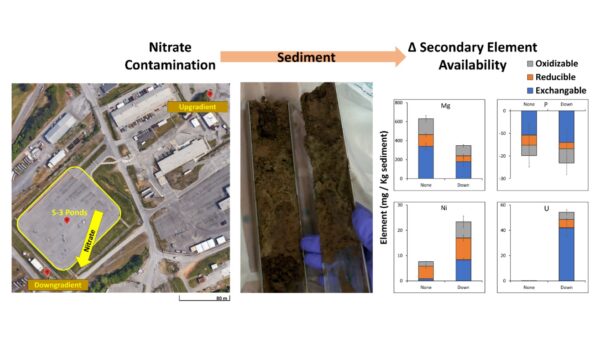
https://doi.org/10.1016/j.envpol.2023.122674.)
The Science
Microbes play an important role in decreasing the impact of contamination in sediment environments. The ability of microbes to survive in sediment is affected by the availability of various elements. While some elements are toxic for microbes at high concentrations, others are essential for growth. In this work, ENIGMA researchers compared the availability of elements in non-contaminated and acidic nitrate contaminated sediment. While several toxic metals from the contamination were more available in the contaminated sediment, several essential elements, including phosphorus, were less available. This could impact the ability of microbes to grow in—and help remediate—nitrate-contaminated environments.
The Impact
This study shows how nitrate, a common environmental contaminant of growing concern, can impact the mobility and availability of several elements. While metals toxic to microbes at high concentrations, such as nickel, copper, and uranium, were more mobile and available in nitrate contaminated sediment, other essential elements like magnesium, calcium and phosphorus were less available. Phosphorus in particular was unavailable for the growth of several microbes from the local environment. This information could help us understand the impact of nitrate contamination on environmental microbes.
Summary
The growth and survival of microbes in the environment is dependent on the presence and availability of both toxic and essential elements. In this study, we investigated the mobility and availability of 18 different elements in two sediment cores located upstream and downstream of a nitrate and mixed metal contamination source. Most elements analyzed, including those that form cations like nickel, copper, cobalt and the oxycation-forming element uranium were more available in the contaminated core. However, oxyanion-forming elements, including phosphorus and molybdenum, were less available. Bioavailability tests using microorganisms from the environment showed that phosphorus was not available for growth from the sediment. This indicates that contamination could be impacting the microbial community not only through toxic mechanisms, but also through the limitation of essential elements. This in turn could impact the longevity of nitrate contamination in the environment.

Contact
Mike Adams, Distinguished Research Professor
University of Georgia – Athens
adamsm@uga.edu
Funding

This study by ENIGMA – Ecosystems and Networks Integrated with Genes and Molecular Assemblies (http://enigma.lbl.gov), a Science Focus Area Program at Lawrence Berkeley National Laboratory that is based upon work supported by the U.S. Department of Energy, Office of Science, Office of Biological & Environmental Research.
Publications
Thorgersen M.P., J.L. Goff, F.L. Poole II, K.F. Walker, A.D. Putt, L.M. Lui, T.C. Hazen, A.P. Arkin, M.W.W. Adams (2023) Mixed nitrate and metal contamination influences operational speciation of toxic and essential elements. Environmental Pollution. [DOI]:10.1016/j.envpol.2023.122674 OSTI:2007162
Related Links
The underlying data for this study has been made available by deposition in the open-access Mendeley Data repository.
